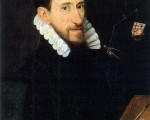
On this day in history events for 29th August to 4th September.
[Read More...]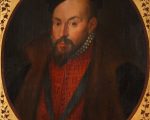
July 1549. The almost twelve-year-old Edward VI had been King of England for two-and-a-half years. Landlords had begun enclosing the common lands, which prevented peasants from being able to have a place for their animals to graze. Several landlords had taken to raising sheep, as the English wool trade was growing quite prosperous. This, in concert with a host of other problems such as inflation and unemployment, led to unrest for the lower classes.
After Edward Seymour, Lord Protector, had issued a proclamation on behalf of Edward VI that made enclosures illegal, several peasants tore down a fence that was raised in the town of Attleborough. On 6 July, the town of Wymondham was observing the illegal feast day for Thomas Beckett. Henry VIII had outlawed any such celebrations or commemorations of Thomas Becket back in 1538. After the festivities, some revellers got together and decided to dismantle some of the enclosures. This was the beginning of the Norfolk uprising and posed a significant threat to the Lord Protector’s government.
[Read More...]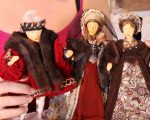
I quite often receive questions about the dolls I have on my bookcase and Margaret asked if I would do a Claire Chats video on them, explaining how/where I got them. So, here you go! My collection is all down to my dear friend Dawn Hatswell – thank you Dawn!
[Read More...]
On Wednesday 9 August 1516, a funeral mass was sung for the soul of Jeroen von Aeken. Better known by his artistic name of Hieronymus Bosch, he was 58 to 66 years old at death. Dying in the city of ’s-Hertogenbosch, located in the Brabant, Bosch may have passed on from pleurisy which was plaguing the city around that time and claimed the lives of his neighbour, a friend, and one of his cousins.
Bosch was born between 1450 and 1457 into a family of painters; his great-grandfather, grandfather, and other relatives were all artists. Bosch likely completed his first works in the family’s studio, where they would sometimes collaborate on works. His paintings featured religious iconography mixed in with sometimes dreamy, sometimes nightmarish elements.
[Read More...]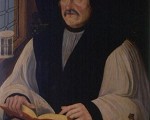
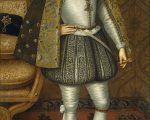
19th June 2016 marks the 450th birthday of King James I and VI of England and Scotland. Unification between the two countries, though at times strained, was brought about by James ascending the throne of England in 1603. The unification was the result of one hundred years of Tudor politics.
Back in 1503, Henry VII arranged for his eldest daughter, Margaret Tudor, to marry James IV of Scotland. Margaret during the course of the marriage gave birth to the future James V in 1512. Fighting between Scotland and England resumed. In 1523, Henry VIII attempted to unite the thrones of Scotland and England by offering his daughter, Princess Mary, as a bride for James V. This proposal was rejected. Moving forward several years, James V married the French Mary of Guise in 1538. Henry VIII had lost his third wife in October 1537 and was seeking a new bride. James V beat his uncle, Henry VIII, who was also trying to marry Mary of Guise. In 1541, James V’s mother and Henry VIII’s sister, Margaret Tudor, passed away; this effectively ended the nearly thirty-year truce between Scotland and England. A war broke out, which saw the death of James V due to illness and depression of the current state of war in December 1542.
[Read More...]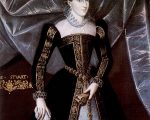
By 15 June 1567, twenty-four-year-old Mary Stuart had been Queen of Scotland for almost her entire life; never knew her father, James V, because he died when she was six days old; was Queen Consort, then Queen, of France for less than seventeen months; had lost her mother in July 1560; was about to celebrate her son and heir’s first birthday on 19 June, and was married to her third husband. Mary’s first husband, King Francis II of France, died three days before Mary’s eighteenth birthday in 1560. Mary’s mother was dead for roughly five months when her first husband died. She married her second husband, Henry Stuart, Lord Darnley, when she was twenty-two. Mary gave birth to her only surviving child, James VI, during her marriage to Darnley. Darnley died, likely murdered, less than two years after the marriage, and Mary married her third husband, James Hepburn, 4th Earl of Bothwell. Bothwell may have had a hand in the death of Mary’s second husband and there is speculation as to whether Mary indeed wanted to marry Bothwell or whether she was coerced into the marriage.
[Read More...]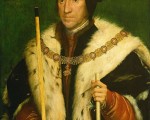
Thomas Howard was the eldest son of Thomas Howard, 2nd Duke of Norfolk, and of Elizabeth Tilney. He was the brother of Elizabeth Boleyn (née Howard) and Edmund Howard so was uncle to Queens Anne Boleyn and Catherine Howard. Howard’s father and grandfather had fought on Richard III’s side at the Battle of Bosworth but Howard was able to work his way back into royal favour by fighting for the Crown against both the Cornish rebels and the Scots in 1497. He was made a Knight of the Garter in 1510, was created Earl of Surrey in 1514 and succeeded his father as Duke of Norfolk in 1524. In September 1514 he was prominent in leading the English army in defeating the Scots at the Battle of Flodden.
[Read More...]
6 May 1527. Pope Clement VII had been sitting on St. Peter’s Chair since 19 November 1523. An illegitimate member of the Medici clan, he was raised by his uncle Lorenzo de’ Medici, known as Lorenzo the Magnificent. His cousin was Pope Leo X, second son of Lorenzo the Magnificent and another Medici. Clement VII was originally trained for military service but showed a great interest in serving the clergy. Though it was traditional for illegitimate sons to be blocked from holding a bishopric, Clement VII’s cousin Leo X elevated him anyway, setting the stage for Clement VII to eventually become pope. Unfortunately, Clement VII proved to be an ineffective statesman and was caught between the powerful leaders of France, the Holy Roman Empire, and England: Francis I, Charles V and Henry VIII, respectively. This being caught between a rock and a hard place would set the stage for Rome to be overrun and defiled.
[Read More...]
Thomas Wriothesley (pronounced Riz-lee) was a prominent member of the court during the reign of King Henry VIII and his son King Edward VI. Born on 21 December 1505, Thomas was the first child and oldest son of William Wriothesley and Agnes, daughter of James Drayton. The couple went on to have three more children, daughters Elizabeth and Anne born in 1507 and 1508 respectively and a second son, Edward born in 1509.
Wriothesley was educated at St Paul’s School, London before he went to Trinity Hall, Cambridge in around 1522. One of his teachers was the famous Stephen Gardiner, Bishop of Winchester, who would play a large role in the religious discussions of Henry VIII’s later years. His fellow students reported that Wriothesley was intelligent, had integrity of mind and was very handsome.
[Read More...]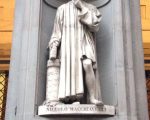
On 3 May 1469, Bartolomea and Bernardo welcomed their first son, Niccolò di Bernardo dei Machiavelli, in Florence, Italy. By the time of Machiavelli’s birth, Florence was the cultural capital of the Tuscan region and is today regarded as the birthplace of the Italian Renaissance. Starting in 1434, the famed Medici family had come to control Florence. Machiavelli would seek to serve the powerful Medici family and write his most famous work, The Prince, in an attempt to convince them to employ him.
[Read More...]
Around 23 April 1564, a great mind was born in a small English market town. Such an immortal mind was baptised on 26 April 1564 in Stratford-upon-Avon in Warwickshire. With inauspicious beginnings as the third of six children born, first to survive infancy, to a leather merchant and landed heiress, William Shakespeare would go on to lead the life of an intellectual lion, whose roar can still be heard throughout the world today.
Shakespeare’s first poems, “The Rape of Lucrece” and “Venus and Adonis” were dedicated to his patron, Henry Wriothesley, Earl of Southampton, in the early 1590s. Beginning around 1594, Shakespeare joined a theatrical company known as the Lord Chamberlain’s Men, with the name changing to the King’s Men upon the accession of James I in 1603. Shakespeare is credited with writing more than 154 sonnets and 37 plays.
[Read More...]
Yay! I’m so excited! On 24th September eighteen of MadeGlobal Publishing’s authors will be in London for “an evening with the authors”. This is your chance to mingle with 18 Tudor history authors (many of whom are Tudor Society contributors), have your photo taken with them by a professional photographer, get their autographs, discuss your book idea with MadeGlobal Publishing, and fire questions at the authors in a Q&A session.
[Read More...]
iguel de Cervantes Saavedra, author of Don Quixote, died on 22 or 23 April 1616 in Madrid. Born in about 1547 to a deaf surgeon, Cervantes spent his childhood in poverty. The profession of surgeon was not at all high-paying. Cervantes’ exact date of birth is unknown, but a baptismal certificate was discovered that lists his baptism date as 9 October. It is posited that Cervantes was born on 29 September, St. Michael’s day, hence his forename of “Miguel.” Cervantes and his family moved from place to place in pursuit of better employment for his father. It is unknown what, if any, formal education Cervantes had, but he did learn how to read and became an avid reader.
[Read More...]
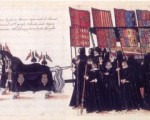
“It is not my desire to live or to reign longer than my life and my reign shall be for your good,” said Elizabeth to her parliament in 1601. Upon one of the many times parliament questioned Elizabeth about her plan of succession, she stated, “I know I am but mortal and so therewhilst prepare myself for death, whensoever it shall please God to send it.” And send it, God eventually did.
24 March, 1603. Elizabeth I, the Virgin Queen, England’s Gloriana and daughter of the great Henry VIII by the ill-fated Anne Boleyn, passed away peacefully in her sleep at Richmond Palace. She was 69 years old and had reigned for almost 45 years.
[Read More...]
In an unassuming hallway leading visitors to the Doge’s Palace in Venice, Italy, from the Staircase of Giants and out through the Porta della Carta, there is an extraordinary feature adorning the ceiling not once, but twice: a Tudor rose.
Daniele Barbaro was a Venetian cardinal, born in 1514 and dying in 1570. During his lifetime, Barbaro translated the works of Vetruvius, a Roman architect, and was known to be a patron of architects. Particularly, he patronized the Venetian architect known as Andrea Palladio. Barbaro, a bit of a linguist, also served as ambassador to the court of Elizabeth I of England. He may also have served as ambassador to Edward VI. Pleased with his service, Elizabeth allowed Barbaro in 1560 to quarter his personal arms with Tudor roses.
[Read More...]
Alessandro Farnese was born on 29 February 1468 at Canino, Latium, which was in the Papal States. Educated at the University of Pisa and Lorenzo de Medici’s court, he was prepared to take on the career of apostolic notary. Changing course, Alessandro joined the Roma Curia in 1491 at the age of approximately 23 and was quickly promoted by the new pope Alexander VI to a cardinal-deacon position at Santi Cosma e Damiano two years later. Alessandro had the early makings of a fine career with the church. His family already boasted of Pope Boniface VIII.
[Read More...]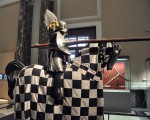
Jousting, much like rugby or American football, was a full-contact, dangerous sport. Severe injuries and even death were quite common. Henry II of France died in 1559 when a lance’s splinter breached Henry’s helmet and entered his brain by way of the eye. More like American football and less like rugby, individuals participating in the joust wore protection.
Most armour was made by smiths in either Germany or Italy, though those smiths would travel to workshops all over the continent and England. One workshop in England boasted of smiths from Flanders, the Netherlands, Germany and Italy. The city of Milan was most famous for its skilled armour smiths, though German armourers under the Holy Roman Empire outfitted the likes of Maximilian I and Charles V. Henry VIII established royal workshops at Greenwich, with previous workshops having been located in London. Some French workshops recruited Italians for their workshops in Lyon and Tours. There is not much information about armour workshops in either Spain or the Netherlands, but most of the large Belgian cities had active armourer’s guilds during the Renaissance period.
[Read More...]

It is thought that Thomas Tallis, alternatively spelled “Tallys,” could have been born on 30 January 1505, though it is not known for certain. What is known is that Tallis did not die until 1585, and that he contributed greatly to the development and composition of English choral music. Not much is known about Tallis’s early life. There are no records of his education or really of his whereabouts until Tallis is well into his 20s. There is also no contemporary portrait of him, with the only existing portrait having been executed sometime after his death.
[Read More...]